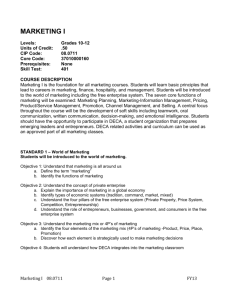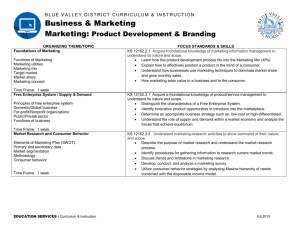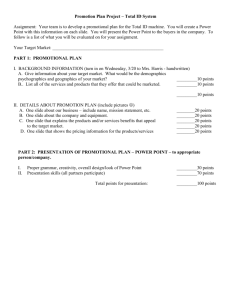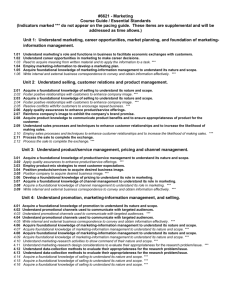File - Herington High School Business/Technology
advertisement
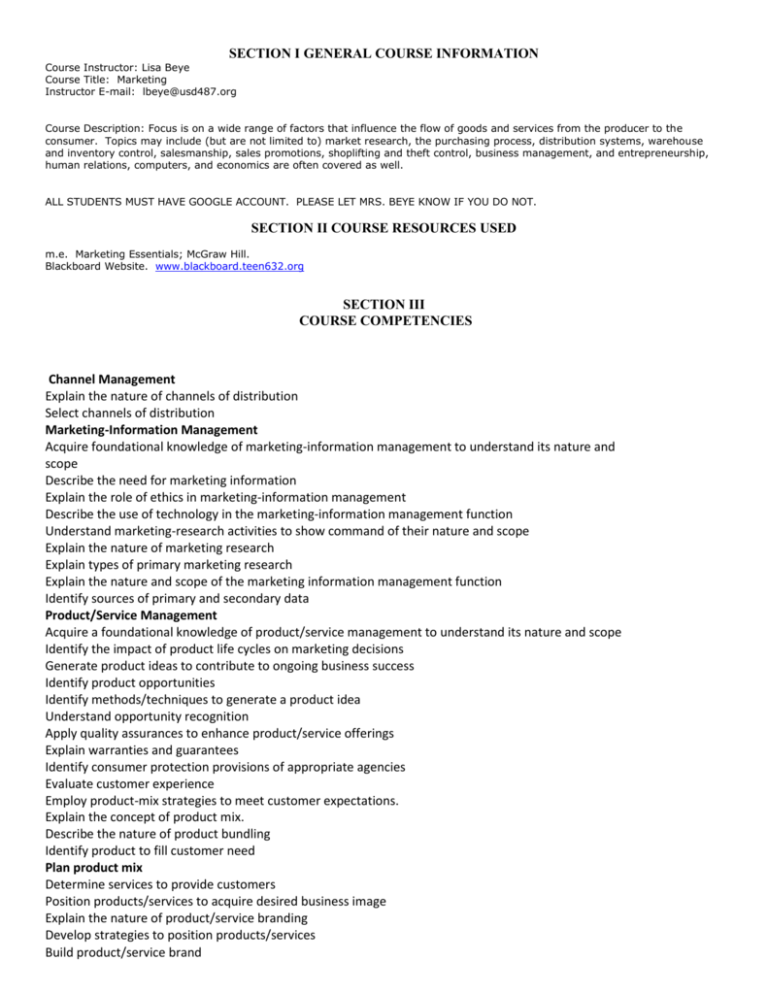
SECTION I GENERAL COURSE INFORMATION Course Instructor: Lisa Beye Course Title: Marketing Instructor E-mail: lbeye@usd487.org Course Description: Focus is on a wide range of factors that influence the flow of goods and services from the producer to the consumer. Topics may include (but are not limited to) market research, the purchasing process, distribution systems, warehouse and inventory control, salesmanship, sales promotions, shoplifting and theft control, business management, and entrepreneurship, human relations, computers, and economics are often covered as well. ALL STUDENTS MUST HAVE GOOGLE ACCOUNT. PLEASE LET MRS. BEYE KNOW IF YOU DO NOT. SECTION II COURSE RESOURCES USED m.e. Marketing Essentials; McGraw Hill. Blackboard Website. www.blackboard.teen632.org SECTION III COURSE COMPETENCIES Channel Management Explain the nature of channels of distribution Select channels of distribution Marketing-Information Management Acquire foundational knowledge of marketing-information management to understand its nature and scope Describe the need for marketing information Explain the role of ethics in marketing-information management Describe the use of technology in the marketing-information management function Understand marketing-research activities to show command of their nature and scope Explain the nature of marketing research Explain types of primary marketing research Explain the nature and scope of the marketing information management function Identify sources of primary and secondary data Product/Service Management Acquire a foundational knowledge of product/service management to understand its nature and scope Identify the impact of product life cycles on marketing decisions Generate product ideas to contribute to ongoing business success Identify product opportunities Identify methods/techniques to generate a product idea Understand opportunity recognition Apply quality assurances to enhance product/service offerings Explain warranties and guarantees Identify consumer protection provisions of appropriate agencies Evaluate customer experience Employ product-mix strategies to meet customer expectations. Explain the concept of product mix. Describe the nature of product bundling Identify product to fill customer need Plan product mix Determine services to provide customers Position products/services to acquire desired business image Explain the nature of product/service branding Develop strategies to position products/services Build product/service brand Promotion Acquire a foundational knowledge of promotion to understand its nature and scope Explain the role of promotion as a marketing function Explain the types of promotion Identify the elements of the promotional mix Describe the use of business ethics in promotion Describe the use of technology in the promotion function Describe the regulation of promotion Understand promotional channels used to communicate with targeted audiences Explain types of advertising media Describe word-of-mouth channels used to communicate with targeted audiences Explain the nature of direct marketing channels Identify communications channels used in sales promotion Explain communications channels used in public-relations activities Understand the use of an advertisement's components to communicate with targeted audiences Explain the components of advertisements Explain the importance of coordinating elements in advertisements Understand the use of public-relations activities to communicate with targeted audiences Identify types of public-relations activities Discuss internal and external audiences for public-relations activities Understand the use of trade shows/expositions to communicate with targeted audiences Explain how businesses can use trade-show/exposition participation to communicate with targeted audiences Explain considerations used to evaluate whether to participate in trade shows/expositions Manage promotional activities to maximize return on promotional efforts Explain the nature of promotional plan Coordinate activities in the promotional mix Market Planning Employ marketing-information to develop a marketing plan Explain the concept of marketing strategies Identify considerations in implementing global marketing strategies Explain the concept of market and market identification Identify market segments Select target market Explain the nature of market planning Explain the nature of marketing plans Explain the role of situational analysis in the marketing planning process Conduct market analysis Conduct SWOT analysis for use in the marketing planning process Identify marketing goals and objectives Explain market budget Understanding elements of marketing plan Pricing Develop a foundational knowledge of pricing to understand its role in marketing Explain the nature and scope of the pricing function Describe the role of business ethics in pricing Explain factors affecting pricing decisions Selling Acquire a foundational knowledge of selling to understand its nature and scope Explain the nature and score of the selling function Explain the role of customer service as a component of selling relationships Explain key factors in building a clientele Explain company selling policies Explain business ethics in selling Describe the use of technology in the selling function Describe the nature of selling regulations Acquire product knowledge to communicate product benefits and to ensure appropriateness of product for the customer Acquire product information for use in selling Identify product information to identify product features and benefits Understand sales processes and techniques to enhance customer relationships and to increase the likelihood of making sales Explain the selling process Discuss motivational theories that impact buying behavior SECTION VI INSTRUCTOR EXPECTATIONS OF STUDENTS IN CLASS Students are expected to show respect for the instructor and their fellow students by arriving to class on time and being attentive the entire class period. Visiting with other students during a lecture or using electronic devices in the classroom (cellular phones, pagers, CD players, etc.) is not appropriate. SECTION IX METHODS OF INSTRUCTION AND EVALUATION The Course Evaluation will include: Guided Notes, Daily Work, Journal Entries, Test and Quizzes and Projects. Grading Standard A = 90 – 100% B = 80 – 89% C = 70 – 79% D = 60 – 69% F = 0 – 59% GRADING POLICIES: A score of zero (0) is recorded for assignments not completed before their due date. SECTION XI COURSE OUTLINE Introduction Assignment Unit 1 Career Development in Marketing Unit 2 Entrepreneurship and Developing your product or service Unit 3 Conducting Market Research Unit 4 Product planning, branding, packaging, and labeling Unit 5 Pricing of your product or service Unit 6 Promotion of your product or service Unit 7 Distribution your product or service Unit 8 Selling your product or service Final Websites and Documents Due
![[1] - Elkhart USD 218](http://s3.studylib.net/store/data/008568416_1-61ade04632c91789dac7ea10427310b3-300x300.png)
